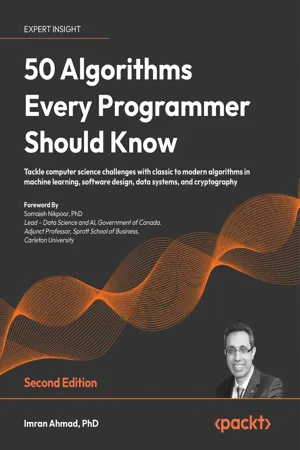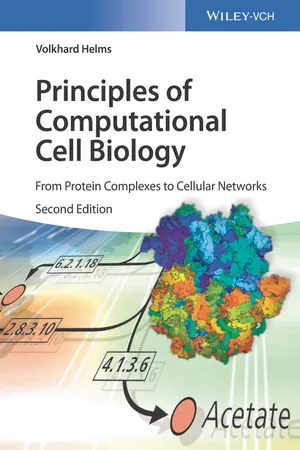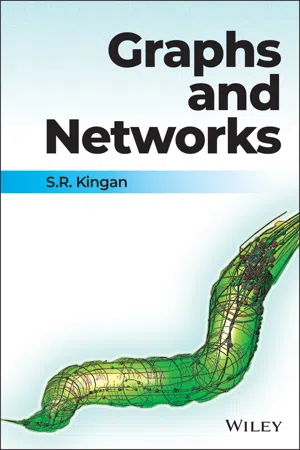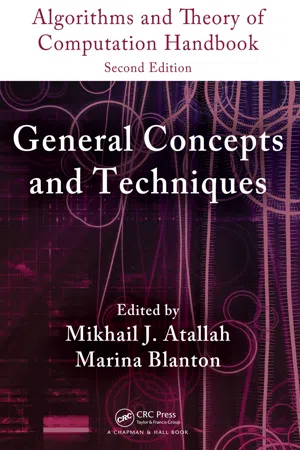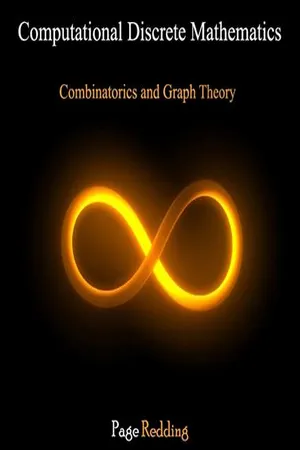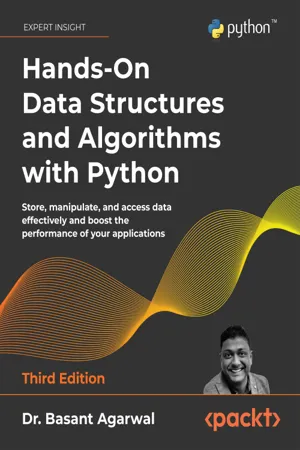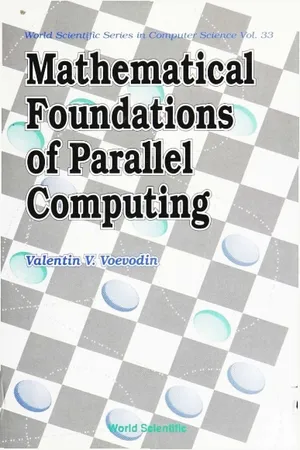Mathematics
Algorithms on Graphs
Algorithms on graphs involve the study and development of methods for solving problems related to graphs, which are mathematical structures consisting of nodes and edges. These algorithms are used to analyze and manipulate graphs, such as finding the shortest path between two nodes or determining if a graph is connected. They have applications in various fields, including computer science, operations research, and network analysis.
Written by Perlego with AI-assistance
Related key terms
1 of 5
12 Key excerpts on "Algorithms on Graphs"
- eBook - PDF
Binary Digital Image Processing
A Discrete Approach
- Stéphane Marchand-Maillet, Yazid M. Sharaiha(Authors)
- 1999(Publication Date)
- Academic Press(Publisher)
Chapter 3 ALGORITHMIC GRAPH THEORY Graph theory is an important mathematical approach which can be used for mapping complex problems onto simple representations and models. It is based on a robust mathematical background which allows for the definition of optimal solution techniques for such problems. Efficient algorithms can thus be derived which can solve a particular problem based on its graph representation. Graph theory is an area of research by itself and finds applications in many fields such as operational research and theoretical computer science. It also finds applications in image processing, where the discrete nature of image represen- tations makes its use consistent. In fact, it is often the case that graph theory is implicitly used when developing a solution to a particular problem related to image processing. The aim here is to relate image processing concepts to al- gorithmic graph theory in order to take advantage of this approach for further developments. In this chapter, we first present in Section 3.1 terminology and definitions used in graph theory. We summarise well-known algorithms which exist for the solution of problems defined in the context of graph theory. Typically, classes of equivalent problems are defined and solutions are presented for abstract repre- sentations of each class. Section 3.2 presents algorithms for the solution of two classic optimisation problems. More precisely, a number of algorithms are pre- sented for the shortest path problem and the minimum weighted spanning tree problem. Finally, Section 3.3 relates these results to digital image processing concepts presented in Chapters 1 and 2. 3.1 Definitions Major definitions used in algorithmic graph theory are reviewed here. The concept of a graph is introduced via the definition of vertices and arcs. These concepts are then extended to that of paths and trees on a graph. - eBook - ePub
50 Algorithms Every Programmer Should Know
An unbeatable arsenal of algorithmic solutions for real-world problems
- Imran Ahmad(Author)
- 2023(Publication Date)
- Packt Publishing(Publisher)
5
Graph Algorithms
Graphs offer a distinct way to represent data structures, especially when compared to structured or tabular data. While structured data, such as databases, excel at storing and querying static, uniform information, graphs shine in capturing intricate relationships and patterns that exist among entities. Think of Facebook, where every user is a node, and each friendship or interaction becomes a connecting edge; this web of connections can be best represented and analyzed using graph structures.In the computational realm, certain problems, often those involving relationships and connections, are more naturally addressed using graph algorithms. At their core, these algorithms aim to understand the structure of the graph. This understanding involves figuring out how data points (or nodes) connect via links (or edges) and how to effectively navigate these connections to retrieve or analyze the desired data.In this chapter, we’ll embark on a journey through the following territories:- Graph representations : Various ways to capture graphs.
- Network theory analysis : The foundational theory behind network structures.
- Graph traversals : Techniques to efficiently navigate through a graph.
- Case study : Delving into fraud analytics using graph algorithms.
- Neighborhood techniques : Methods to ascertain and analyze localized regions within larger graphs.
Upon completion, we will have a robust grasp of graphs as data structures. We should be able to formulate complex relationships—both direct and indirect—and will be equipped to tackle complex, real-world problems using graph algorithms.Understanding graphs: a brief introduction
In the vast interconnected landscapes of modern data, beyond the confines of tabular models, graph structures emerge as powerful tools to encapsulate intricate relationships. Their rise isn’t merely a trend but a response to challenges posed by the digital world’s interwoven fabric. Historical strides in graph theory, like Leonhard Euler’s pioneering solution to the Seven Bridges of Königsberg problem, laid the foundation for understanding complex relationships. Euler’s method of translating real-world issues into graphical representations revolutionized how we perceive and navigate graphs. - eBook - ePub
Principles of Computational Cell Biology
From Protein Complexes to Cellular Networks
- Volkhard Helms(Author)
- 2018(Publication Date)
- Wiley-VCH(Publisher)
4 Algorithms on Mathematical GraphsIn this chapter, we introduce the mathematical object of a graph and some basic algorithms that operate on graph structures. These concepts are essential for analyzing the topologies of protein–protein interaction networks in Chapter 6 using undirected graphs and for analyzing gene‐regulatory networks in Chapter 9 using directed graphs.4.1 Primer on Mathematical Graphs
A graph G is an ordered pair (V, E) of a set V of vertices and of a set E of edges (Figure 4.1 ). E is always a subset of the set V(2) of unordered pairs of V, which consists of all possible connections between all vertices. If E = V(2) , we say the graph is fully connected. In this chapter, we will consider fully connected subsets of the full graph that are also called cliques. A weighted graph has a real‐ or integer‐valued weight assigned to each edge. A subgraph of a graph G is a graph whose vertex and edge sets are subsets of those of G.Figure 4.1 A mathematical graph consists of vertices and edges. (a) An undirected graph is shown consisting of four vertices (A, B, C, and D) and five edges (connections). This example could represent the results from a yeast two‐hybrid experiment probing binary protein–protein interactions that gave positive results for five interactions A–B, A–D, A–C, B–C, and C–D. (b) Almost the same system is shown, but this time as a directed graph with arrows (arcs) instead of edges. This example could, for example, visualize a gene regulatory network where a transcription factor A controls the expression of genes B, C, D, etc. Here, A, B, C, and D are the four vertices of the graph, and the five arcs are the directed edges of the graph.A path in a graph is a sequence of vertices such that from each of its vertices there is an edge to the successor vertex. The first vertex is called the start vertex, and the last vertex is called the end vertex. Both of them are called end or terminal vertices of the path. The other vertices in the path are internal vertices. Two paths are independent (alternatively called internally vertex‐disjoint) if they do not have any internal vertex in common (Figure 4.2 ). Given an undirected graph, two vertices u and v are called connected if there exists a path from u to v. Otherwise, they are called disconnected. The graph is called a connected graph if every pair of vertices in the graph is connected. A connected component is a maximal connected subgraph. Here, maximal means that it can only be enlarged by rearranging the edges. The giant component - eBook - PDF
- S. R. Kingan(Author)
- 2022(Publication Date)
- Wiley(Publisher)
113 5 Graph Algorithms This chapter introduces graph algorithms, the third major topic in the book along with theory and applications. Graph algorithms is an interdisciplinary area covering both mathematics and computer science. A thorough understanding requires knowing computational complexity (see Appendix C), data structures (see Appendix D), and a programming language in order to implement the algorithms. Nonetheless, it is possible to understand the algorithms and their importance in a more theoretical manner. Generally speaking graph algorithms can be divided into two broad classes: existence algorithms and optimization algorithms. An existence algorithm finds the property, invariant, or object of interest. An optimization algorithm finds the best option among a set of options. Section 5.1 presents two algorithms that determine whether or not a graph is connected; if the graph is connected, the algorithms find a spanning tree. They are examples of existence algorithms. Section 5.2 presents two algorithms for finding a minimum weight spanning tree in a weighted graph. Both use a “greedy strategy.” They are examples of optimization algorithms. Section 5.3 presents Dijkstra’s Shortest Path Algorithm for weighted graphs, another optimization algorithm. Richard Karp introduced the concept of NP-complete in his 1972 paper “Reducibility among combinatorial problems” and highlighted several graph invariants as being intractable (Karp, 1972). As such it is worth studying the problems in this chapter since they have nice and efficient algorithms. 5.1 Traversal Algorithms In this section we examine two algorithms to determine if a graph is connected: Depth-First Search (DFS) and Breadth-First Search (BFS). The input for both DFS and BFS is a graph and a starting vertex (call it s). Both algorithms search the graph by traversing edges from vertex to vertex, building a spanning tree as they proceed. - eBook - PDF
- Bozzano G Luisa(Author)
- 2014(Publication Date)
- Elsevier Science(Publisher)
CHAPTER 10 Graph Algorithms J. van LEEUWEN Department of Computer Science, University of Utrecht, P.O. Box 80.089, 3508 TB Utrecht, Netherlands Contents Prelude 527 1. Representation of graphs 527 2. Basic structure algorithms 551 3. Combinatorial optimization on graphs 579 References 612 HANDBOOK OF THEORETICAL COMPUTER SCIENCE Edited by J. van Leeuwen © Elsevier Science Publishers B.V., 1990 This page intentionally left blank Prelude GRAPH ALGORITHMS 527 Graphs are the most common abstract structure encountered in computer science. Any system that consists of discrete states or sites (called nodes or vertices) and connections between it can be modeled by a graph. The connections between nodes of a graph are called edges (in case the connections are between unordered pairs of nodes), directed edges (in case the connections are between ordered pairs of nodes), or hyperedges (in case the connections are arbitrary nonempty sets of nodes). Connections may also carry additional information as labels or weights, related to the interpretation of the graph. Consequently there are many types of graphs and many basic notions that capture aspects of the structure of graphs. Also, many applications require efficient algorithms that essentially operate on graphs. In this chapter we give an overview of the common paradigms and results in graph algorithms with an emphasis on the more recent developments in the field. We outline the underlying principles of many essential graph algorithms, but usually omit the details of the carefully tuned datastructures that may be needed to achieve the ultimate bounds on time or space complexity for the algorithms. We will only deal with ordinary sequential algorithms, and consider a discussion of parallel and distributed Algorithms on Graphs as beyond the scope of this chapter. - eBook - PDF
Algorithms and Theory of Computation Handbook, Volume 1
General Concepts and Techniques
- Mikhail J. Atallah, Marina Blanton(Authors)
- 2009(Publication Date)
- Chapman and Hall/CRC(Publisher)
7 -22 References ................................................................ 7 -23 7.1 Introduction Graphs provide a powerful tool to model objects and relationships between objects. The study of graphs dates back to the eighteenth century, when Euler defined the Königsberg bridge problem, and since then has been pursued by many researchers. Graphs can be used to model problems in many areas such as transportation, scheduling, networks, robotics, VLSI design, compilers, mathematical biology, and software engineering. Many optimization problems from these and other diverse areas can be phrased in graph-theoretic terms, leading to algorithmic questions about graphs. Graphs are defined by a set of vertices and a set of edges, where each edge connects two vertices. Graphs are further classified into directed and undirected graphs, depending on whether their edges are directed or not. An important subclass of directed graphs that arises in many applications, such 7 -1 7 -2 General Concepts and Techniques as precedence constrained scheduling problems, are directed acyclic graphs (DAG). Interesting subclasses of undirected graphs include trees , bipartite graphs , and planar graphs . In this chapter, we focus on a few basic problems and algorithms dealing with graphs. Other chapters in this handbook provide details on specific algorithmic techniques and problem areas deal-ing with graphs, e.g., randomized algorithms (Chapter 12), combinatorial algorithms (Chapter 8), dynamic graph algorithms (Chapter 9), graph drawing (Chapter 6 of Algorithms and Theory of Computation Handbook, Second Edition: Special Topics and Techniques ), and approximation algo-rithms (Chapter 34). Pointers into the literature are provided for various algorithmic results about graphs that are not covered in depth in this chapter. 7.2 Preliminaries An undirected graph G = ( V , E ) is defined as a set V of vertices and a set E of edges. An edge e = ( u , v ) is an unordered pair of vertices. - No longer available |Learn more
Computational Discrete Mathematics
Combinatorics and Graph Theory
- (Author)
- 2014(Publication Date)
- Orange Apple(Publisher)
________________________ WORLD TECHNOLOGIES ________________________ Chapter- 7 Algorithm and Graph Theory Algorithm This is an algorithm that tries to figure out why the lamp doesn't turn on and tries to fix it using the steps. Flowcharts are often used to represent algorithms graphically. In mathematics, computer science, and related subjects, an algorithm (derived from the name of mathematician al-Khwārizmī) is an effective method for solving a problem expressed as a finite sequence of steps. Algorithms are used for calculation, data ________________________ WORLD TECHNOLOGIES ________________________ processing, and many other fields. (In more advanced or abstract settings, the instructions do not necessarily constitute a finite sequence, and even not necessarily a sequence; see, e.g., nondeterministic algorithm.) Each algorithm is a list of well-defined instructions for completing a task. Starting from an initial state, the instructions describe a computation that proceeds through a well-defined series of successive states, eventually terminating in a final ending state. The transition from one state to the next is not necessarily deterministic; some algorithms, known as randomized algorithms, incorporate randomness. A partial formalization of the concept began with attempts to solve the Entscheidungsproblem (the decision problem) posed by David Hilbert in 1928. Subsequent formalizations were framed as attempts to define effective calculability or effective method; those formalizations included the Gödel–Herbrand–Kleene recursive functions of 1930, 1934 and 1935, Alonzo Church's lambda calculus of 1936, Emil Post's Formulation 1 of 1936, and Alan Turing's Turing machines of 1936–7 and 1939. The adjective continuous when applied to the word algorithm can mean: 1. An algorithm operating on data that represents continuous quantities, even though this data is represented by discrete approximations – such algorithms are studied in numerical analysis; or 2. - eBook - PDF
- Michael McMillan(Author)
- 2007(Publication Date)
- Cambridge University Press(Publisher)
C HAPTER 16 Graphs and Graph Algorithms T he study of networks has become one of the great scientific hotbeds of this new century, though mathematicians and others have been studying networks for many hundreds of years. Recent developments in computer technology (i.e., the Internet), and in social theory (the social network, popularly con-ceived in the concept of “six degrees of separation”), have put a spotlight on the study of networks. In this chapter, we look at how networks are modeled with graphs. We’re not talking about the graphs such as pie graphs or bar graphs. We define what a graph is, how they’re represented in VB.NET, and how to implement important graph algorithms. We also discuss the importance of picking the correct data representation when working with graphs, since the efficiency of graph algorithms is dependent on the data structure used. G RAPH D EFINITIONS A graph consists of a set of vertices and a set of edges . Think of a map of your state. Each town is connected with other towns via some type of road. A map is a type of graph. Each town is a vertex and a road that connects two towns is an edge. Edges are specified as a pair , (v1, v2), where v1 and v2 are two vertices in the graph. A vertex can also have a weight , sometimes also called a cost. 283 284 GRAPHS AND GRAPH ALGORITHMS A B C D E F G H F IGURE 16.1. A Digraph (Directed Graph). A graph whose pairs are ordered is called a directed graph , or just a digraph . An ordered graph is shown in Figure 16.1 . If a graph is not ordered, it is called an unordered graph , or just a graph. An example of an unordered graph is shown in Figure 16.2 . A path is a sequence of vertices in a graph such that all vertices are connected by edges. The length of a path is the number of edges from the first vertex in the path to the last vertex. A path can also consist of a vertex to itself, which is called a loop . - Dr. Basant Agarwal(Author)
- 2022(Publication Date)
- Packt Publishing(Publisher)
9
Graphs and Algorithms
Graphs are a non-linear data structure, in which the problem is represented as a network by connecting a set of nodes with edges, like a telephone network or social network. For example, in a graph, nodes can represent different cities while the links between them represent edges. Graphs are one of the most important data structures; they are used to solve many computing problems, especially when the problem is represented in the form of objects and their connection, e.g. to find out the shortest path from one city to another city. Graphs are useful data structures for solving real-world problems in which the problem can be represented as a network-like structure. In this chapter, we will be discussing the most important and popular concepts related to graphs.In this chapter, we will learn about the following concepts:- The concept of the graph data structure
- How to represent a graph and traverse it
- Different operations and their implementation on graphs
Graphs
A graph is a set of a finite number of vertices (also known as nodes) and edges, in which the edges are the links between vertices, and each edge in a graph joins two distinct nodes. Moreover, a graph is a formal mathematical representation of a network, i.e. a graph G is an ordered pair of a set V of vertices and a set E of edges, given as G = (V, E) in formal mathematical notation.An example of a graph is shown in Figure 9.1 :Figure 9.1: An example of a graphThe graph G = (V, E) in Figure 9.1 can be described as below:- V = {A, B, C, D, E}
- E = {{A, B}, {A, C}, {B, C}, {B, D}, {C, D}, {D, D}, {B, E}, {D, E}}
- G = (V, E)
- Node or vertex : A point or node in a graph is called a vertex. In the preceding diagram, the vertices or nodes are A , B , C , D , and E and are denoted by a dot.
- Edge : This is a connection between two vertices. The line connecting A and B
- eBook - PDF
- Yogesh Singh(Author)
- 2011(Publication Date)
- Cambridge University Press(Publisher)
3 Essentials of Graph Theory Graph theory has been used extensively in computer science, electrical engineering, communication systems, operational research, economics, physics and many other areas. Any physical situation involving discrete objects may be represented by a graph along with their relationships amongst them. In practice, there are numerous applications of graphs in modern science and technology. Graph theory has recently been used for representing the connectivity of the World Wide Web. Global internet connectivity issues are studied using graphs like the number of links required to move from one web page to another and the links which are used to establish this connectivity. It has also provided many ways to test a program. Some testing techniques are available which are based on the concepts of graph theory. 3.1 WHAT IS A GRAPH? A graph has a set of nodes and a set of edges that connect these nodes. A graph G = (V, E) consists of a non-empty finite set V of nodes and a set E of edges containing ordered or unordered pairs of nodes. V = (n 1 , n 2 , n 3 ……..n m ) and E = (e 1 , e 2 , e 3 ………e k ) If an edge e i E is associated with an ordered pair or an unordered pair (n i , n j ), where n i , n j V, then the e i is said to connect the nodes n i and n j . The edge e i that connects the node n i and n j is called incident on each of the nodes. The pair of nodes that are connected by an edge are called adjacent nodes. A node, which is not connected to any other node, is called an isolated node. A graph with only isolated nodes is known as null graph. If in graph G = (V, E), each edge e i E is associated with an ordered pair of nodes, then graph G is called a directed graph or digraph. If each edge is associated with an unordered pair of nodes, then a graph G is called an undirected graph. - V V Voevodin(Author)
- 1992(Publication Date)
- World Scientific(Publisher)
Chapter 1 Algorithm and Its Graph Before we s t a r t our study of structure of algorithms, we must spe-c i f y precisely the subject f o r inquiry, the goal of our investigations and the mathematical apparatus to be used i n the process. The accurate problem formulation i s of special importance i n the rather loose re-search area dealing with algorithms. We cannot hope to achieve a sub-s t a n t i a l u t i l i t a r i a n success while studying a r b i t r a r y algorithms. Clearly, we s h a l l have to r e s t r i c t our research to a certain class of algorithms. But what should the nature of that class be, and how do we describe i t ? The answer to t h i s question is not immediately clear. I t is obvi-ous, however, that i t involves some kind of compromise between our de-mands and our capacity to meet them. To a certain, probably large, ex-tent we s h a l l benefit by preferring to analyze only the algorithms that can be implemented on various computers. I t i s t h i s choice that permits us to o u t l i n e the following research plan. To define a class of algorithms we essentially have to specify a number of ways they can be put i n w r i t i n g . This amounts to specifying a class of programs f o r e x i s t i n g or hypothetical computers. We w i l l not characterize classes of algorithms and programs In f u l l d e t a i l . I n -stead, we w i l l t r y to discover some basic structure describing the key kernels of algorithms (or the most important portions of algorithms). Using that basic structure we w i l l devise an abstract computational system which we w i l l c a l l a graph machine. Moreover, we w i l l build a whole set of such machines. Then we w i l l revise our problem: instead of studying the structure of algorithms we w i l l study the functioning of graph machines. Putting t h i s plan into effect w i l l allow us to solve two problems of paramount Importance.- eBook - PDF
- Peter Grossman(Author)
- 2017(Publication Date)
- Red Globe Press(Publisher)
Introduction to graph theory 10.1 What is a graph? The objects that we study in the branch of mathematics known as graph theory are not graphs drawn with x and y axes. In this chapter, the word ‘graph’ refers to a structure consisting of points (called ‘vertices’), some of which may be joined to other vertices by lines (called ‘edges’) to form a network. Structures of this type abound in computing. The computers on a site may be connected into a local area network, which in turn may be linked to wider networks, including the Internet. The circuitry inside a computer (which we represented schematically by digital circuit diagrams in Chapter 8) provides another example of a graph or network structure. At a more abstract level, we saw in Chapter 5 how a relation on a set can be depicted using a diagram that takes the form of a graph. There is a particular type of graph called a tree , which we will study in Chapter 11. Trees are used in computing to represent the structure of expressions; we saw an example of a logical expression tree in Chapter 4. Trees can also be used to represent decision processes, in which we are faced with two or more choices at each step of a procedure; the tree diagrams in Chapter 9 were of this type. In this chapter, we introduce graphs, study their basic properties, and investigate some practical problems in which they can be applied. In Chapter 11, we will study trees and investigate some of their applications to computing. 10.2 Basic concepts in graph theory Definition A graph consists of a non-empty set of points, called vertices (singular: vertex ), and a set of lines or curves, called edges , such that every edge is attached at each end to a vertex. 180 CHAPTER 10 An example of a graph is shown in Figure 10.1, with the edges and vertices labelled. An edge is said to be incident to the vertices to which it is attached. For example, the edge e 1 is incident to the vertices v 1 and v 2 in the graph in Figure 10.1.
Index pages curate the most relevant extracts from our library of academic textbooks. They’ve been created using an in-house natural language model (NLM), each adding context and meaning to key research topics.

